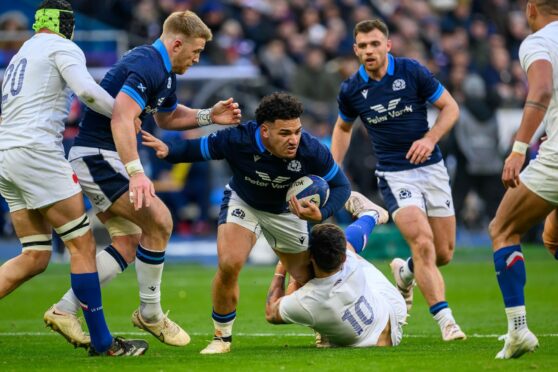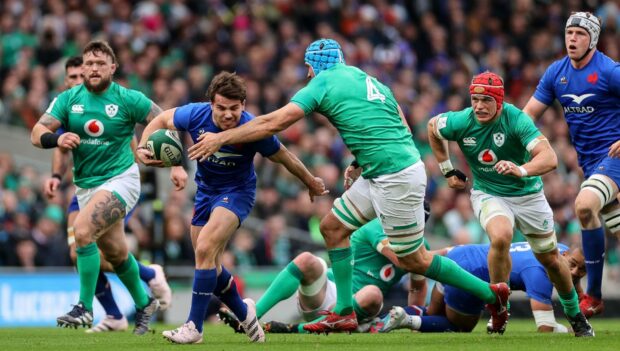You knew it’d be along, as regular as the swallows in spring.
Super Rugby, now consisting of just New Zealand, Australia and Pacific Island teams, kicks off when the Guinness Six Nations is just underway, and someone way down south gets carried away.
“Super Rugby > Six Nations” becomes a meme on social media. Usually with some footage of an undeniably gorgeous try.
For much of the time Super Rugby has run concurrently with the Six Nations, they had a point. The southern hemisphere competition was always easier on the eye.
While the three major nations of the SH were in ascendancy, they had a point in quality of play.
But even renaming the Tri-Nations as The Rugby Championship – with the focus on “THE” – everyone knew what the most important event in rugby was.
This is the best era of the Six Nations
The rankings ⬆️⬇️#GuinnessSixNations pic.twitter.com/jtkxon4jUA
— Guinness Six Nations (@SixNationsRugby) February 27, 2023
Even when it was a muddy arm-wrestle, one tournament had the sold-out stadiums. In fact, for a while a higher capacity per available seat than any sporting tournament in the world.
And now the Six Nations matters even more. The two top teams are also the top two ranked teams in the world.
And some of the rugby in the last three years has been incredible. Better than anything before the championship, or as good as the southern hemisphere has ever produced.
This column has often decried the sepia-tinted view of many that rugby union was a more attractive and flowing game in the ‘golden years’, whenever you happen to date them.
I’d encourage anyone of that view in their mind’s eye to find footage which will assuredly convince them their memories are failing them. Unless you really like mistakes and lineouts.
The modern game is far better. The championship is played with an efficiency, an elan and an innovation we’ve never seen before.
Attack is superior to defence – at least at the moment. Simple grunt is no longer enough, you’ve got to have runners cutting angles and proper athleticism.
Even kicking has advanced beyond South Africa’s 2019 fusillade of high balls to become something much more tactical and subtle.
Ireland’s evolution under Andy Farrell
You see this evolution with World No 1 Ireland, the only team left with Grand Slam aspirations. Just a couple of years ago they were all relentless power and efficiency, maul and latch, maximum pressure on the ball at contact, box kick after box kick.
They still have all of that, if needed. But under Andy Farrell they’ve pivoted to a much looser, open style, where not every point they score comes via a setpiece in the 22 won by a midfield penalty.
Ireland were often a brutally tough watch under Joe Schmidt. Farrell has unquestionably moved them on.
You also see the evolution with France. Last year they outplayed everyone with a combination of the traditional power pack, some peerless ability at half-back and the typically French pace and handling in the backs.
All while anchored with a Shaun Edwards defence and much improved fitness.
There’s been some evidence in the three games in 2023 that France might have peaked a little too early. But their loss in Dublin still looks like being their only one over an 18 month period going into the World Cup.
You also see the evolution with Scotland. Happily the change in the game has matched with our personnel, and gradually since the end of the last Six Nations Scotland have become a competitive force.
Having so many playmakers – and arguably the single most innovative player in the world at the helm – has helped.
Scotland can get by with a slightly undersized pack thanks to setpiece efficiency and the renaissance of a 34-year-old lock who is a nightmare on opposition lineout throws.
Finn and the backs do the rest. Saturday’s trio of scores in Paris took it to 32 of 38 tries since the 2022 Six Nations and 25 of the 28 scored since November scored by the backs. (one was a penalty try, but that was really Stuart Hogg’s).
Italy’s rise is real
So close, yet so far 🤏@Federugby go agonisingly close to putting themselves back in contention against Ireland with just over 10 minutes to go in Rome.#ITAvIRE | @Simo_RAgusi pic.twitter.com/CemItaz9Iu
— Guinness Six Nations (@SixNationsRugby) February 27, 2023
Italy have come to this party as well. Their defence is not yet up to the standards of the top three teams and hence they’ve still lost all three games thus far. But their attacking game has carried constant threat.
The two teams left behind in this evolution so far are England and Wales.
After three games you see no indication that England’s Steve Borthwick is really up to speed in modern rugby trends. He’s reverted to a batch of present or former Leicester stalwarts.
To cap it all off, he dropped Marcus Smith from his squad and recalled George Ford at the beginning of this week.
Owen Farrell, after all the furore over whether he should even be allowed to play or not, has actually looked more like a flanker than a ten. He continues to mindlessly kick away possession with uncommon relish.
He was a great player in the predominant style of the game four, five years ago. Now, it’s not clear he’s a viable 10 in the modern era. The game moves fast.
Fast too, for Warren Gatland. Once it started badly for Wales, you heard a few voices whispering that it had been Shaun Edwards all along.
Obviously, it’s been fraught at Wales Vale of Glamorgan base, with a mixture of over-valuing and rank WRU incompetence meaning some players are reportedly facing 85% pay cuts. And it was always going to take time for Gat to get embedded again.
But he’s not helping by flailing from one selection to the next – Alun Wyn, Faletau, Tipuric dropped, then restored, Halfpenny recalled, Lee Williams dropped then restored then dropped again, Dan Biggar dropped..what’s going on?
During the 2021 Lions Tour, it looked to me that the game had moved on from Gat-ball. There’s even more evidence of that now.

